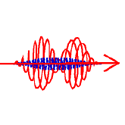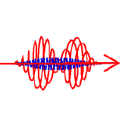Attoseconds for all
Attosecond physics is a burgeoning field in which researchers use ultrashort optical pulses to excite atoms and molecules and follow the electron dynamics. Driving atoms with longer-duration pulse sequences can generate trains of attosecond pulses, but what workers in this field really need are isolated attosecond pulses. However, the technologies for slicing out single pulses can be complex and difficult to implement. Now, Ximao Feng and colleagues at Kansas State University, US, report in Physical Review Letters a relatively straightforward procedure for producing single pulses as short as attoseconds.
Existing methods to pick a single pulse from a pulse train, a technique called “gating,” rely on controlling the light’s amplitude or polarization. Feng et al. have improved upon previous efforts in which two-color gating (interference of the driving laser frequency plus its second harmonic) and polarization gating (two counterrotating circularly polarized pulses that only drive attosecond pulse generation when they form a linear polarization) create a single pulse. The downside of these methods was that they put stringent limits on how long the driving pulses could be. By using elliptically polarized pulses, Feng et al. have been able to relax the requirements so that longer driving pulses, which are much easier to create in the lab, can be used. Moreover, the generated ultrashort pulses can have much higher energies, placing them in the realm of strongly nonlinear attosecond physics. – David Voss





